Lightly sweetened, maple oat sourdough sandwich bread features whole rolled oats and whole wheat flour. It has a soft tender crumb and earthy flavor, ideal for sammies and toast! Use a fluffy, doubled in size Sourdough Bread Starter for the best crumb. This recipe is vegetarian and vegan friendly.
⭐️⭐️⭐️⭐️⭐️ Recipe: “Found this recipe a couple of months ago and it turns out perfect every time! It’s my new go to for sandwich bread.” ~ Kris
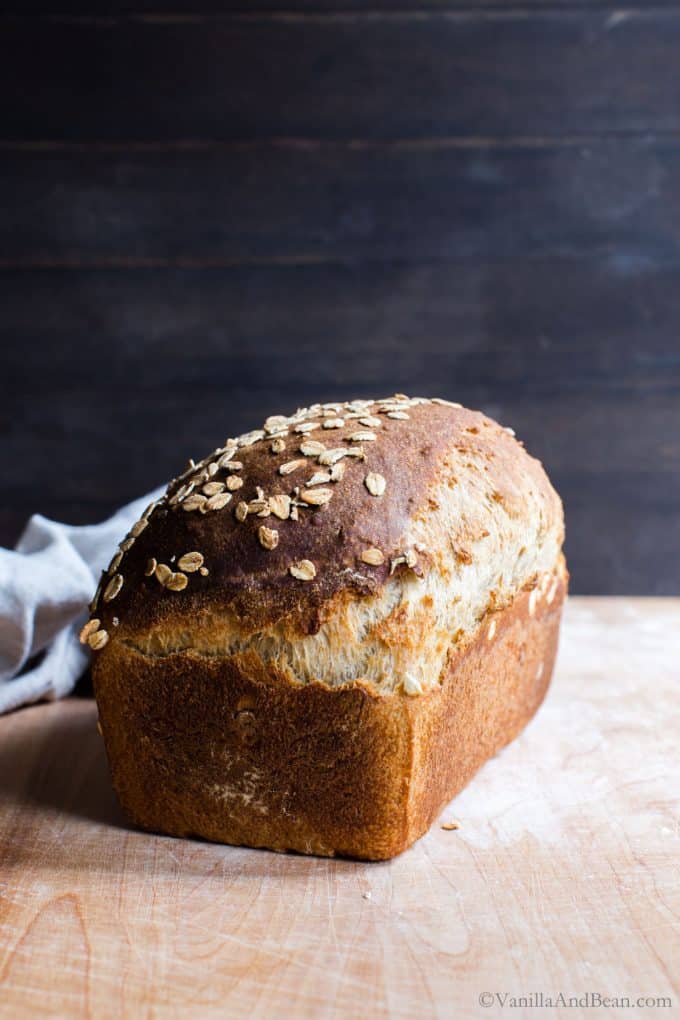
Table of Contents
Sourdough Love
There are many sourdough variations, and while I adore a crusty classic or multigrain sourdough, I can never pass up a softer loaf for toast, sandwiches, and French toast.
So I set out to create a softer loaf with earthy flavors in the shape of traditional sandwich bread. This loaf is my favorite after tweaking the ingredients and testing to see if it holds up to the sandwich test.
Maple oat sourdough is tender, soft, light, and with the earthiest of notes. Lightly sweetened, featuring rolled oats and whole wheat flour, its rustic flavors shine.
Related: Looking for a sourdough starter? Follow my DIY Sourdough Starter recipe.
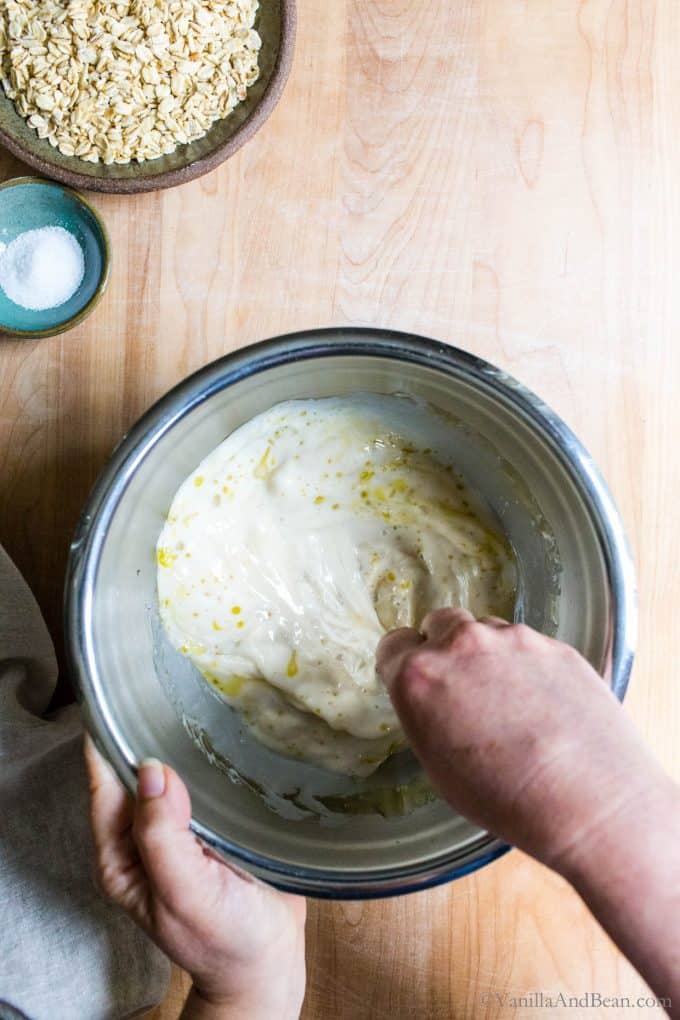
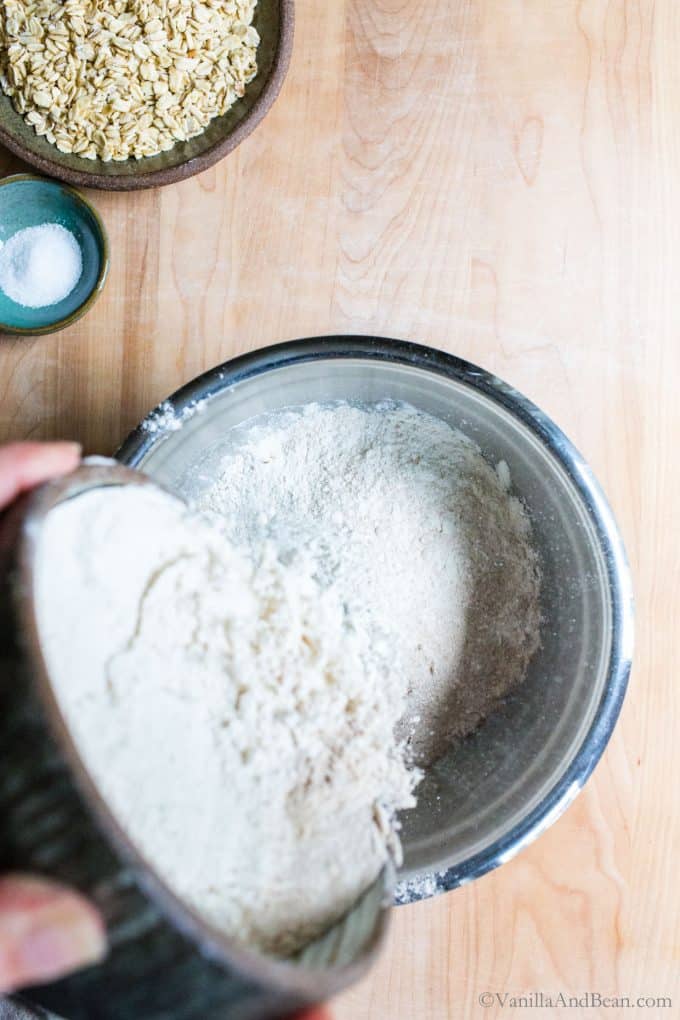
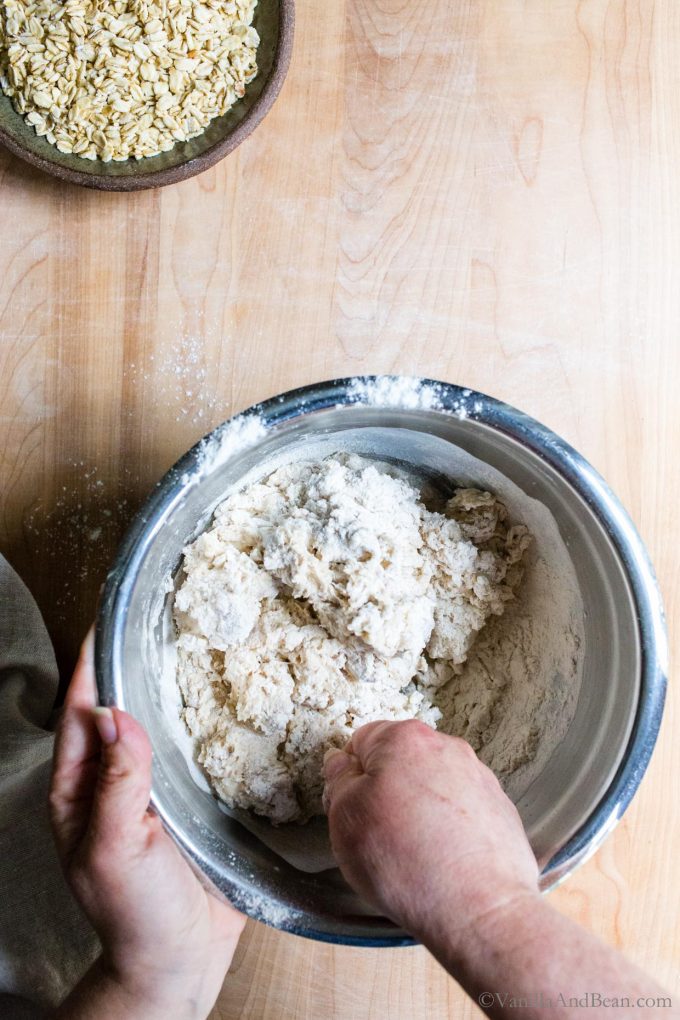
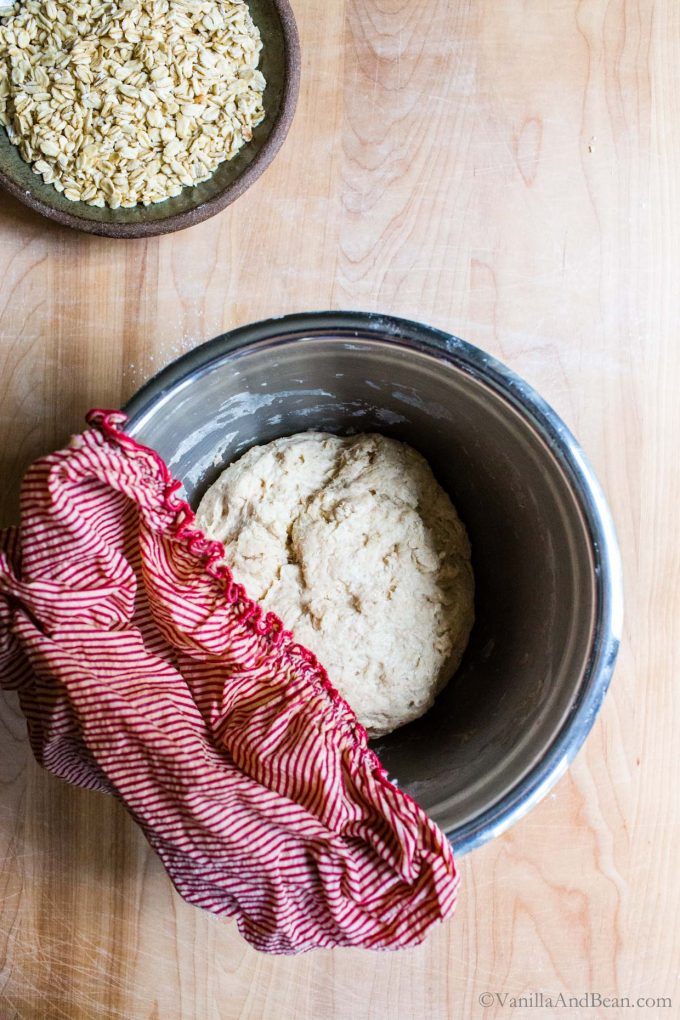
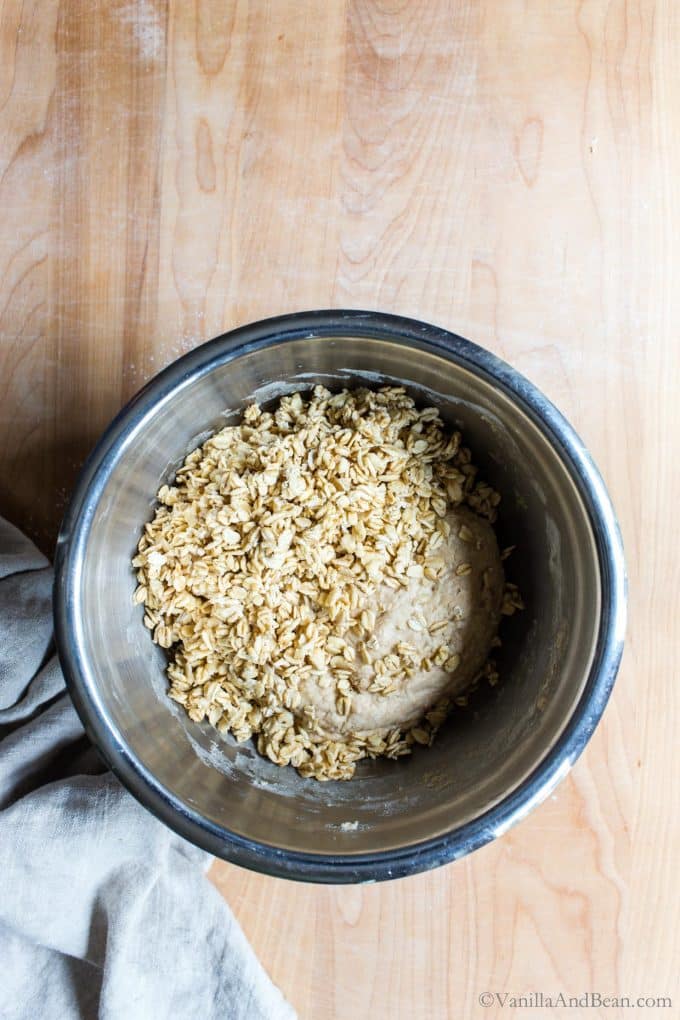
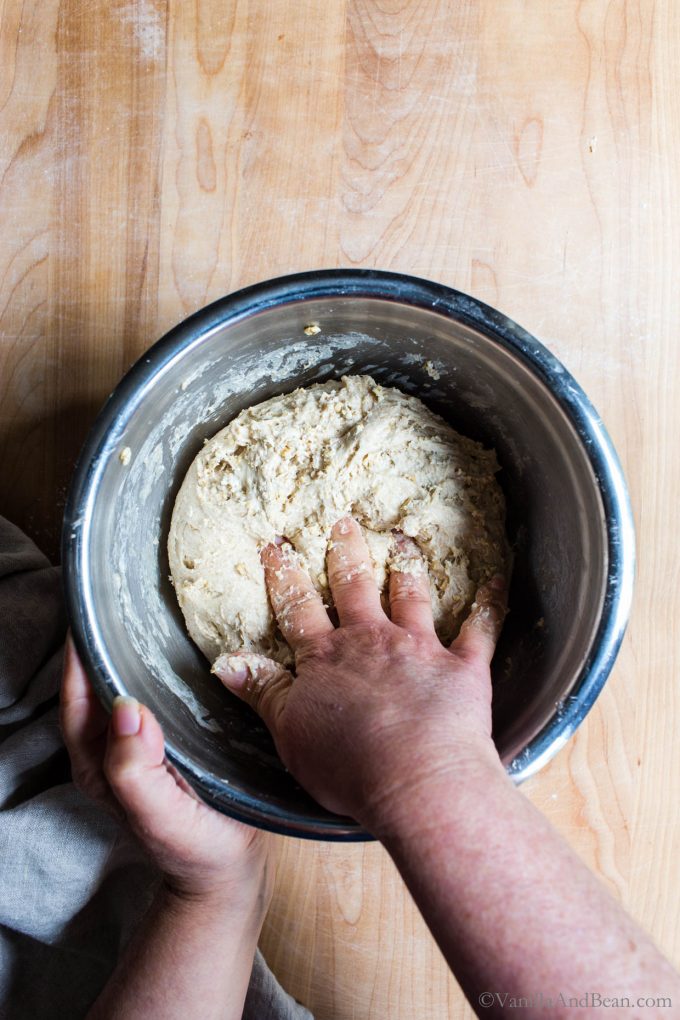
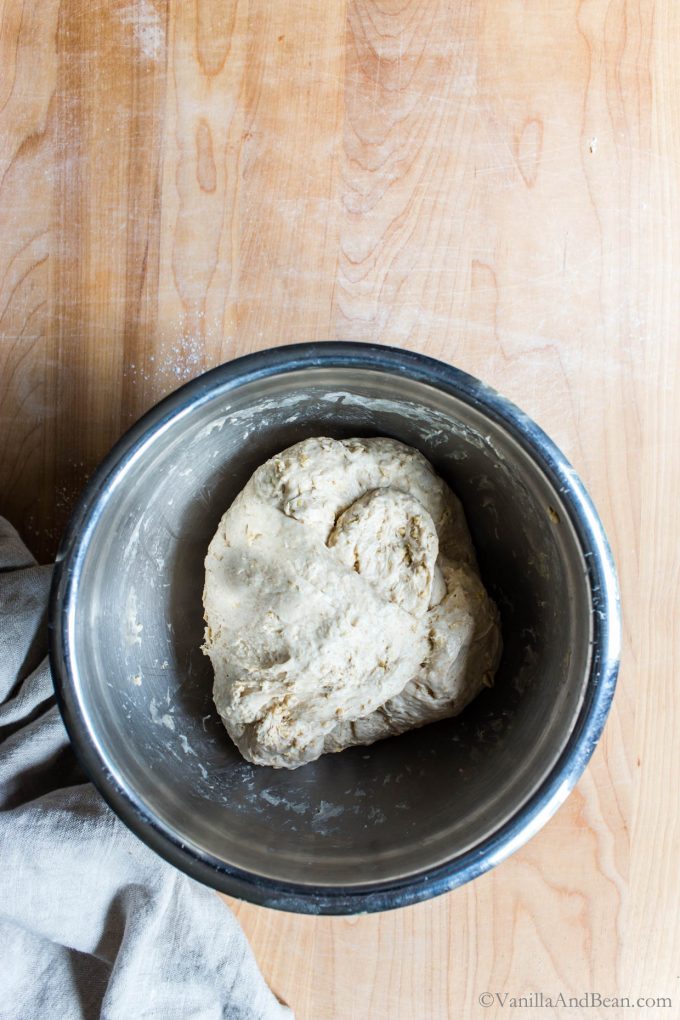
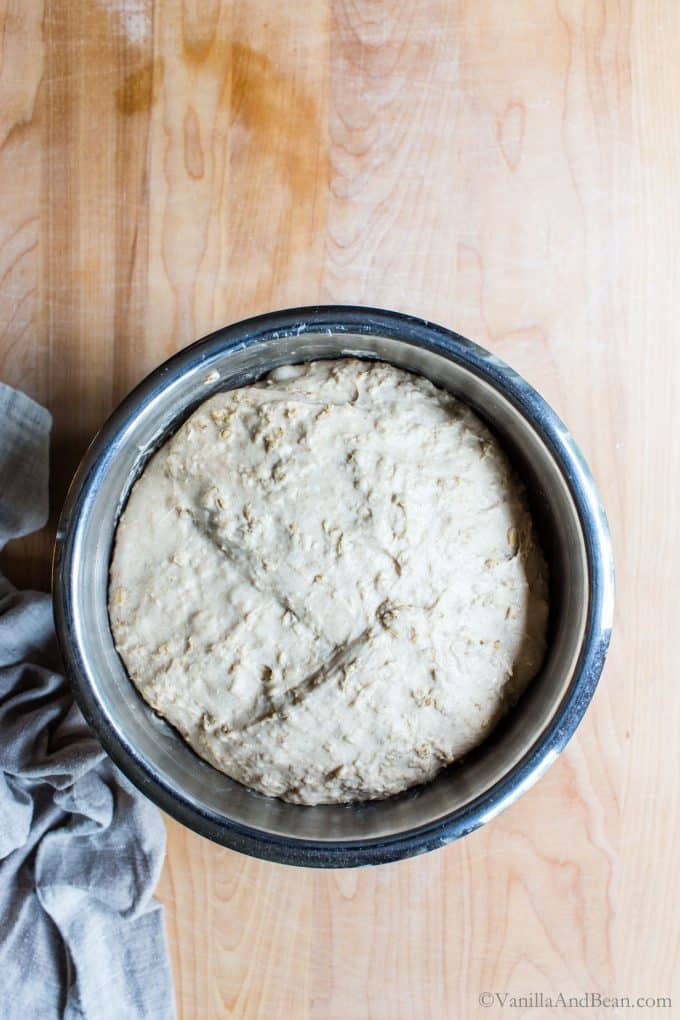
How to Make Maple Oat Sourdough Sandwich Bread
If you’re into making sourdough, you know it’s a process. Thing is, most of it is hands-off time waiting for the dough to develop, waiting for it to rest, then waiting for it to come out of the oven. I tend to think about it longer than it takes the hands-on time necessary to make it!
In summary, here’s how to make this sourdough:
- First, pour water over the soaker (in this case, rolled oats) then mix the dough.
- Second, cover and rest the dough for 30 minutes.
- Third, mix in the soaker.
- Fourth, cover and rest the dough for 30 minutes.
- Fifth, fold the dough.
- Sixth, cover and rest the dough for 30 minutes, and then fold one last time OR continue resting right into bulk fermentation at room temperature for about 8-12 hours (at 70F). It will be doubled in size before moving on to the next step.
- Continuing, pull the dough from the bowl and fold the dough, rest for 20 minutes, then shape and pan.
- Next, proof the dough for between 1-2 hours or until the dough rises from 3/4″- 1″ above the lip of the pan at the center.
- Last, spritz the dough with water, sprinkle with oats, and bake for 45-55 minutes.
Allow the dough to cool for at least an hour before slicing into it as the crust and crumb development continues as the sourdough cools. A practice in patience.
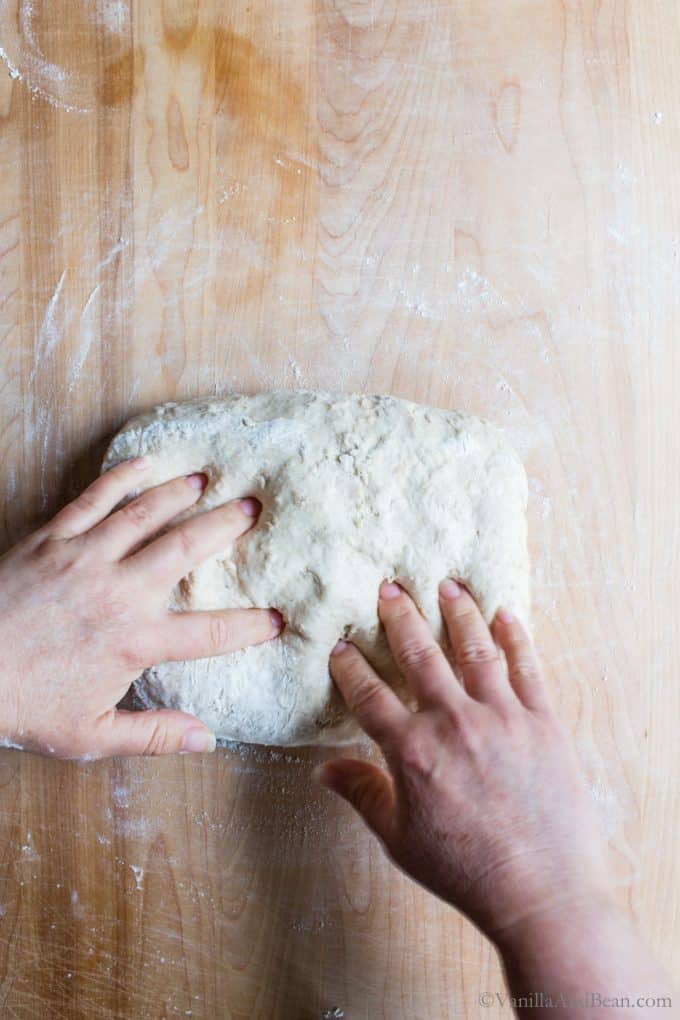
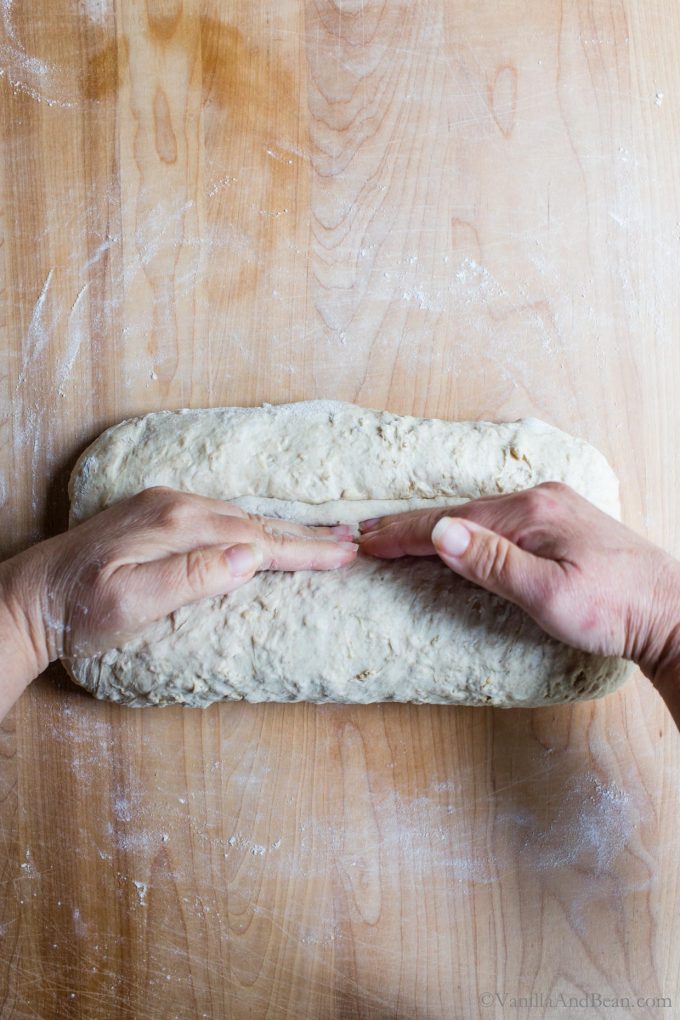
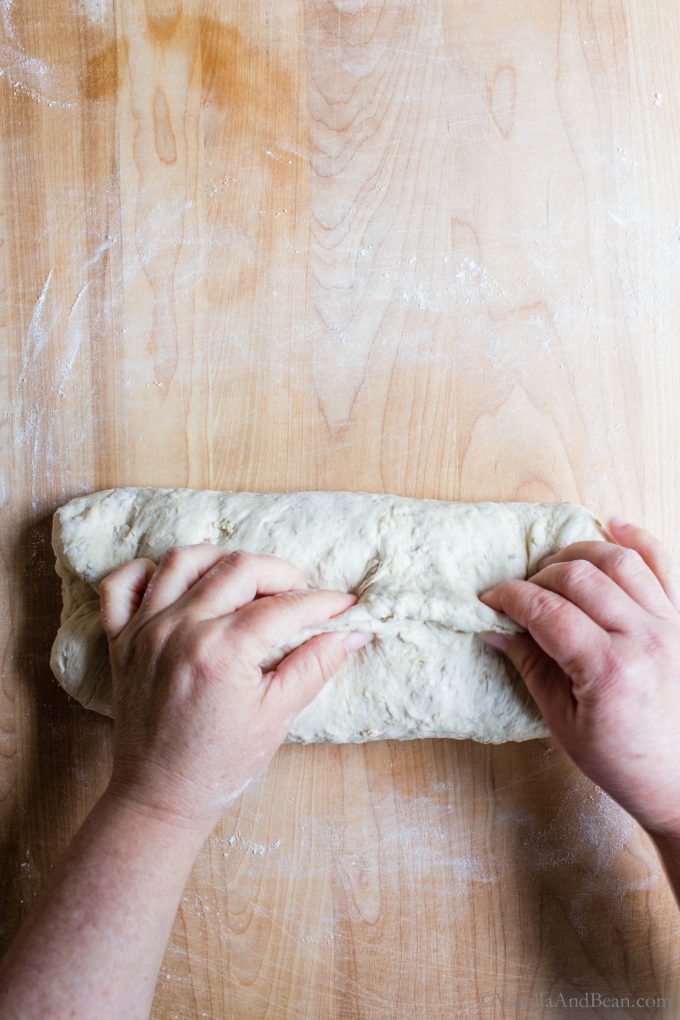
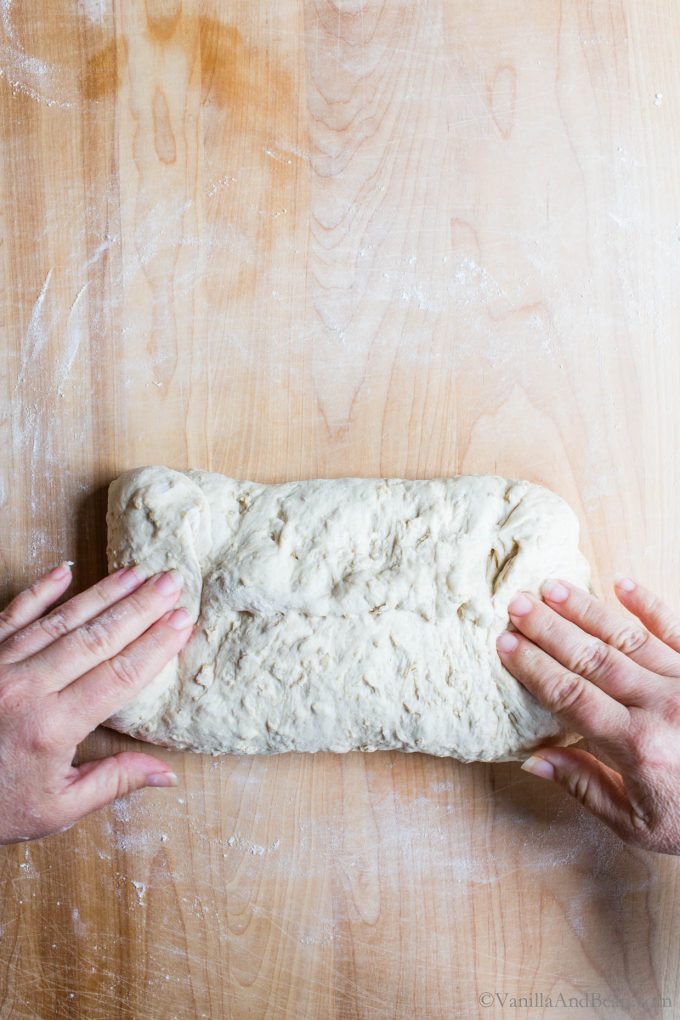
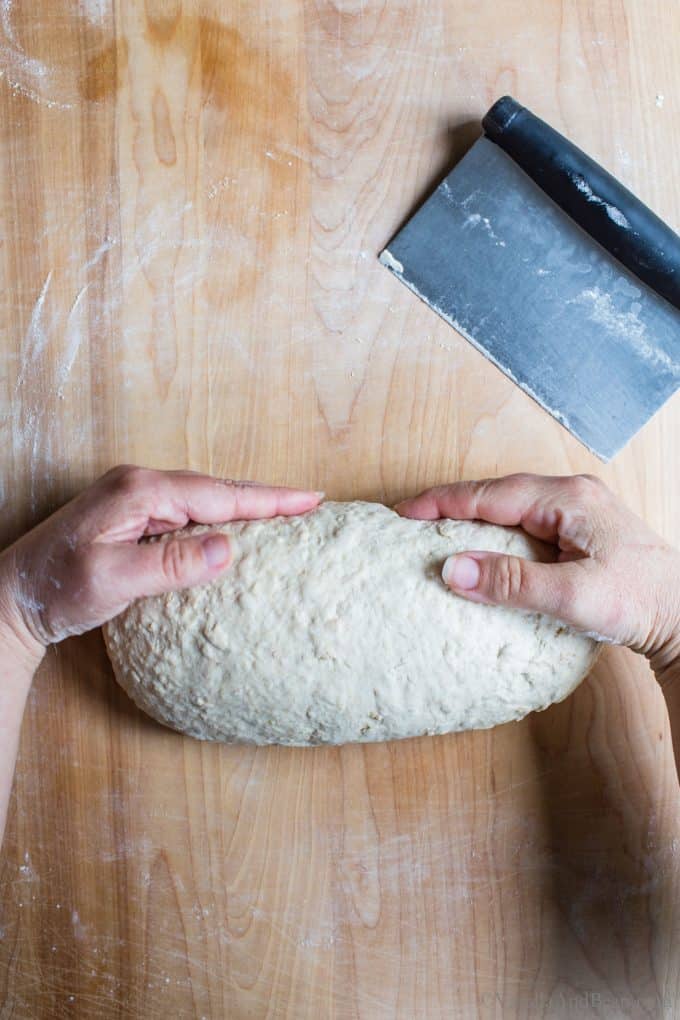
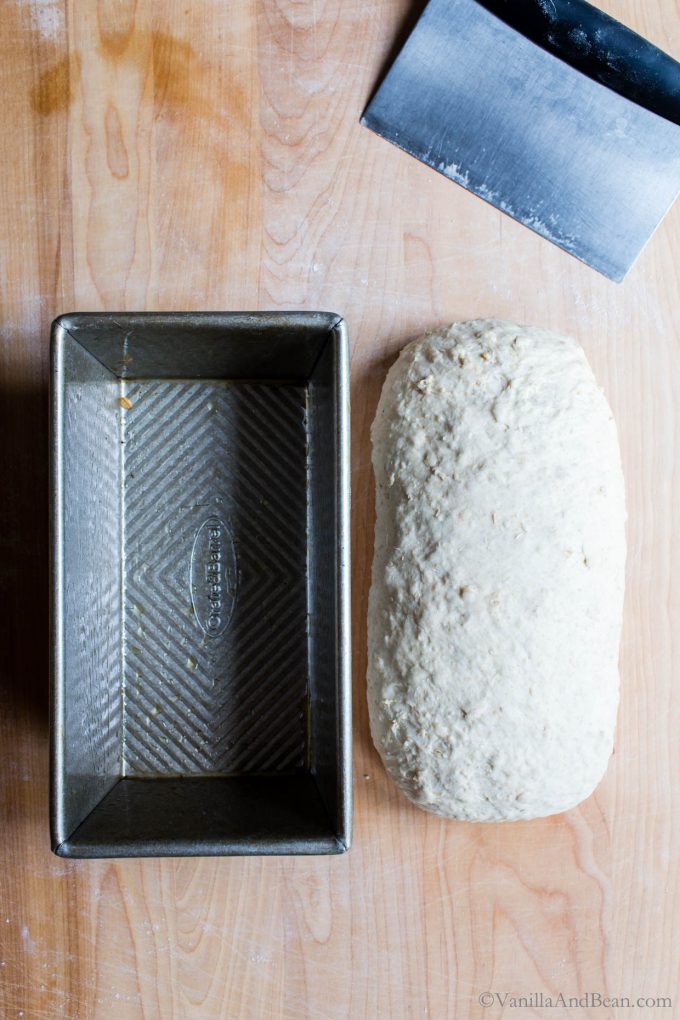
Fitting Sourdough into Your Schedule
When it comes to sourdough, fitting it into your schedule can be achieved through a little strategic planning and, if needed, using a technique I keep in my back pocket for when something comes up and I need to extend the time between mixing and proofing…
…because things come up, right?
Retarding the dough is optional but is a tool for bread bakers. Retardation is simply the process of placing the dough in the refrigerator to slow down fermentation so the rise takes longer. This is handy for flavor development but also, as a time management tool.
Looking for more sourdough recipes to challenge your bread-baking prowess? Check out my collection of Sourdough Bread Recipes and use your discard in these Sourdough Discard Recipes.
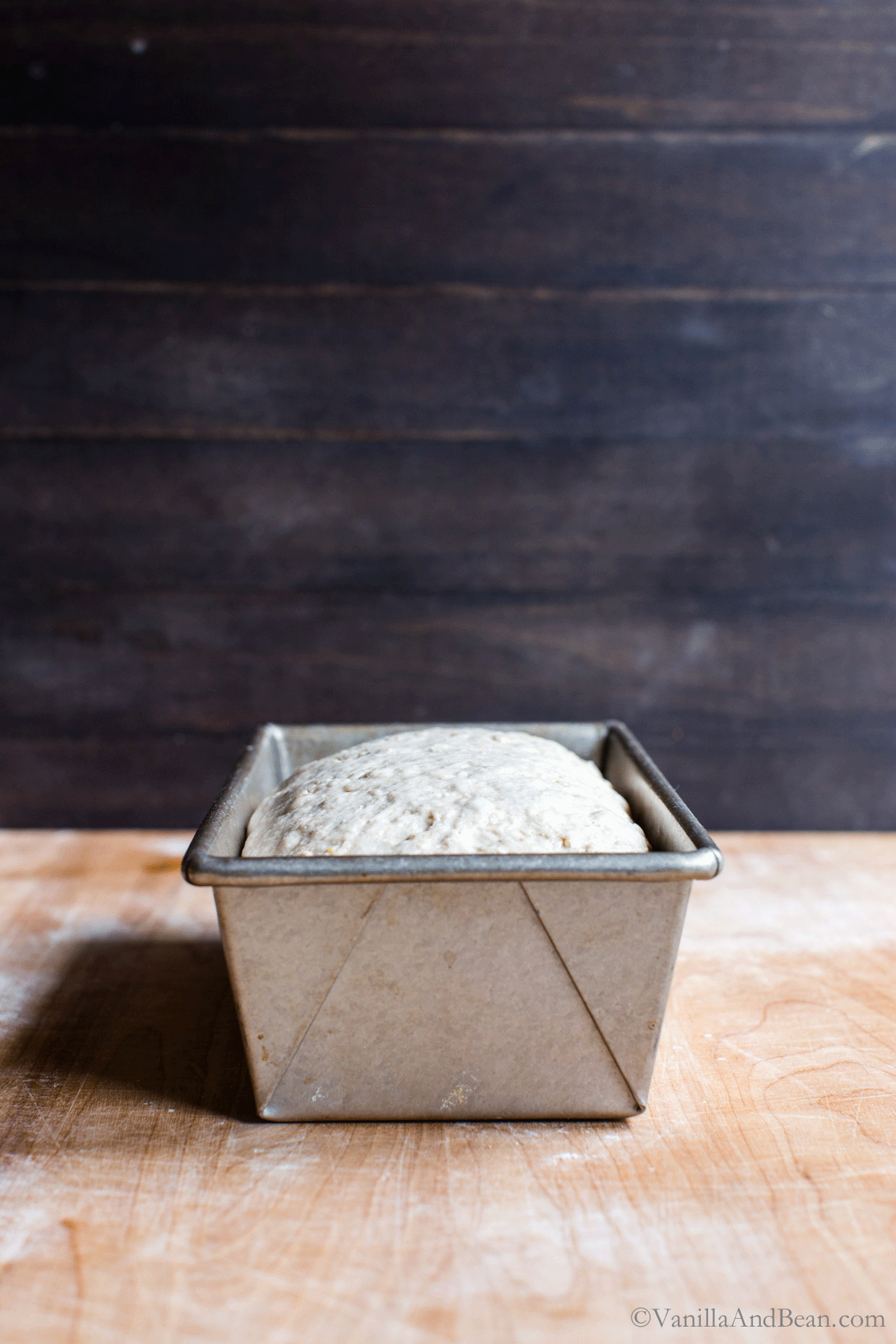
When to Retard the Dough
There are several times in which the dough can be retarded:
- during bulk fermentation – first rise
- during proof – second rise
During Bulk: retard during bulk to slow down the rise allowing flexibility for when the dough will be shaped, proofed and baked. The dough still needs to double in size during bulk fermentation (first rise), so after refrigeration I pull it to room temperature, and let it finish rising, until it doubles in size. I’ve not tested the limits of this, but up to about 10 hours in the refrigerator generally fits my schedule.
I like to do this when I mix in the morning. I just pop it in the fridge for the day, then pull it to room temperature before I go to bed. It’s doubled in size by morning!
During Proof: It’s possible, but I’ve not yet mastered retarding proofing dough (proof/second rise). I tend to overproof it because I’ve waited too long. This is a skill I continue to work on. Some bakers say a cold proofed dough is easier to score and produces better oven spring.
Either way longer fermentation produces more complex flavors in the bread. After all, time = flavor in the sourdough world. And I notice this too. Sometimes it’s subtle, but sometimes the sour flavor is more apparent.
When is the First Rise (bulk) Done?
Knowing when bulk is complete takes a little practice and a watchful eye. Bulk fermented dough is ready for shaping when:
-
- it no longer looks or feels dense
- is jiggly when the bowl is shaken
- has about doubled in size
- you may see a few large bubbles on the surface of the dough
When is the Second Rise (proof) Done?
When the dough has risen in the loaf pan to about 3/4″ – 1″ (2cm – 2.54cm) above the lip of the pan at the center. Have a ruler ready for this part! The amount of time it takes to proof will vary depending on ambient temperature. At 70F (21C) proofing takes about an hour. It can take up to twoish hours in a chilly kitchen (raises hand!).
If you’d like to speed this process along, you can put the loaf in a turned off oven with the light on. Just be sure to remove the loaf before preheating your oven for baking!
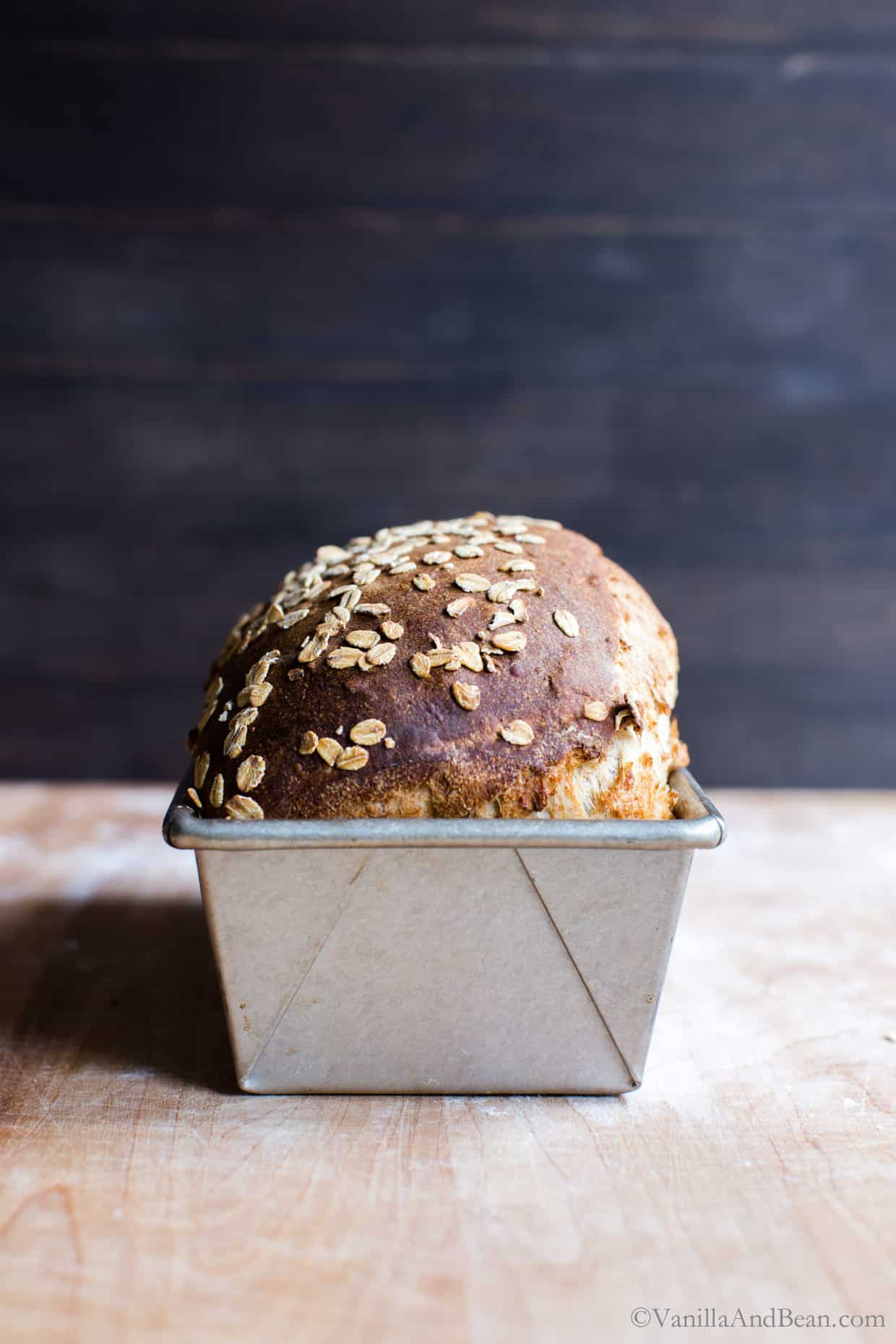
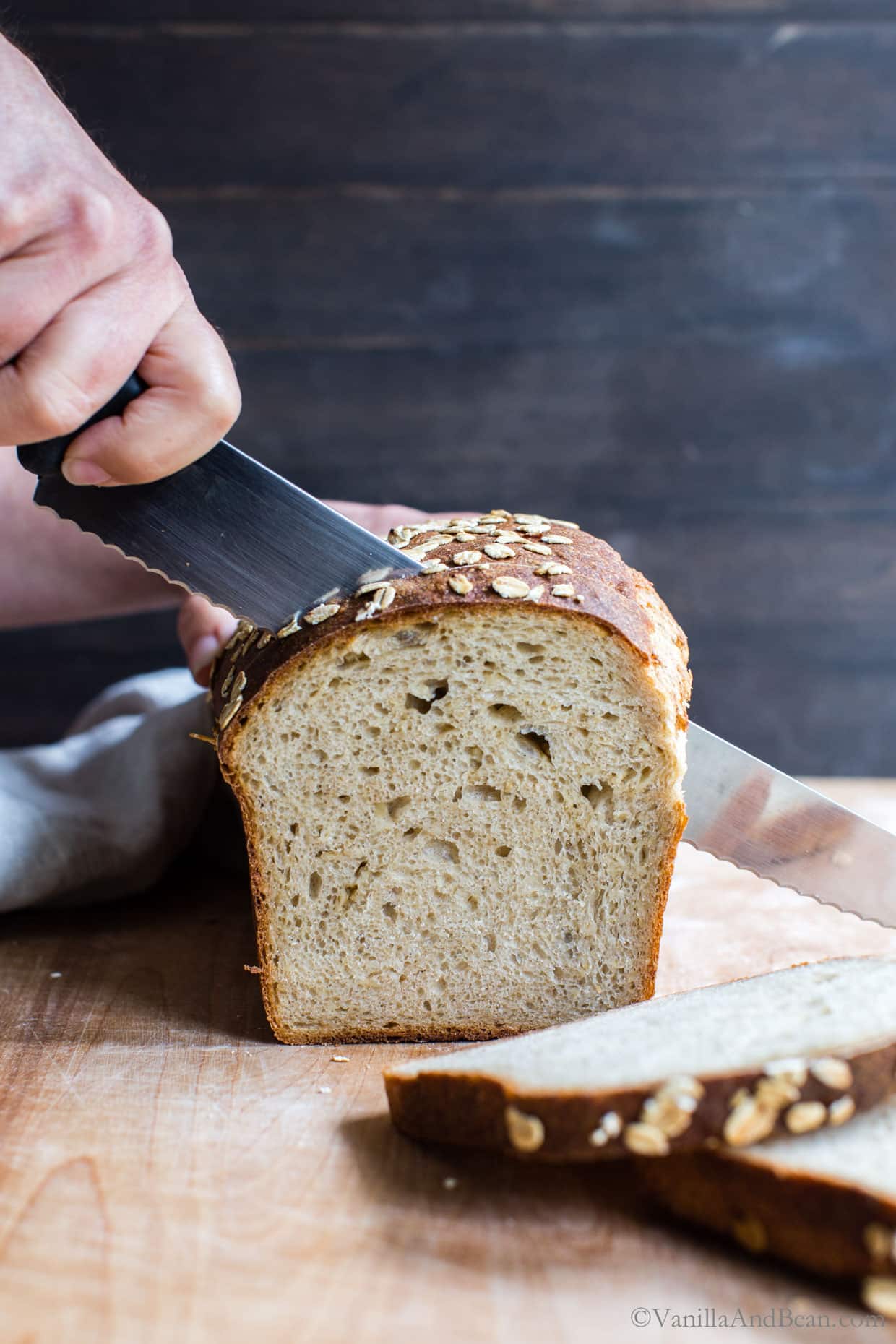
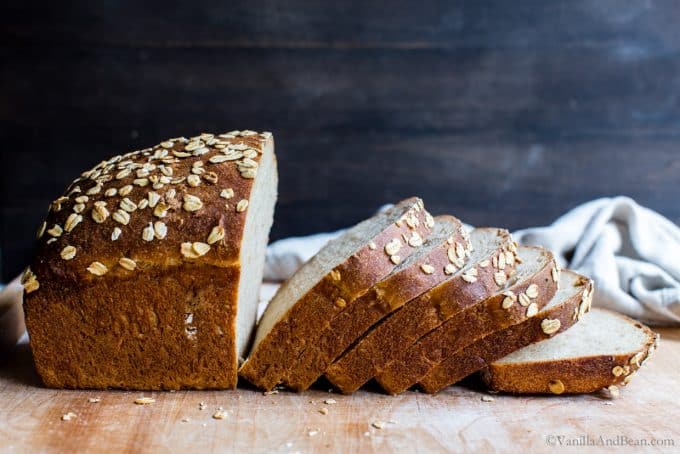
Expert Tips
- Looking for a Starter? Check out how to make a sourdough starter!
- Whole Wheat Bread Flour: this maple oat sourdough sandwich bread calls for whole wheat bread flour, which can sometimes be hard to find. If unavailable, use regular whole wheat flour. The difference is subtle, but whole wheat bread flour yields a little bit stretchier dough and is easier to work with.
- Internal Temperature: to know when the Sourdough Oat Bread is done baking, check the internal temperature using a digital thermometer (affiliate). When done, they should read between 190 – 205 Fahrenheit (88 – 96 Celsius).
- Kitchen Tools: I recommend a digital oven thermometer with an air probe for monitoring accurate oven temperature and weighing your ingredients using a digital kitchen scale for best outcome (affiliate links).
- The whole rolled oats are a nice surprise in this dough. They soften as the dough ferments, so they’re barely noticeable yet add a lovely, earthy flavor and whole grain nourishment.
- Freezer friendly? Yes please! Store baked bread in a freezer bag, either whole or sliced, for up to two weeks. Thaw at room temperature. If using for toast, toast directly from the freezer to oven.
More Sourdough Recipes to Love
- Cranberry Orange Sourdough Bread
- Rustic Sourdough Bread
- Sourdough Hamburger Buns
- Soft Sourdough Dinner Rolls
- Sourdough Pizza Dough
- Sourdough Pita Bread
Maple Oat Sourdough Sandwich Bread Recipe
Ingredients
For the Soaker:
- 1 C (100g) Whole Rolled Oats plus 2 Tbs for the top
- 1/2 C (105g) Water room temperature
For the Dough:
- 3/4 C (150g) Sourdough Starter 100% hydration, previously feed and bubbly
- 1 C (230g) Milk (nut milk or whole dairy milk) I use 1/2 diluted unsweetened cashew milk - 80F (26C)
- 1/4 C (80g) Maple Syrup
- 1 Tbs (14g) Olive Oil + more for oiling the pan
- 1/2 C + 1 Tbs (100g) Whole Wheat Bread Flour (see note**) or whole wheat flour
- 2 C + 3 1/2 Tbs (300g) Bread Flour
- 1 1/2 tsp (10g) Fine Sea Salt
Instructions
For the Soaker:
- Add the oats to a small bowl and pour the water over them. The water wont fully cover the oats - that's okay. Set aside.
For the Dough:
- Mix the Dough: In the evening, whisk the starter, milk, maple syrup and oil together in a large bowl with a fork. Add the flours and salt. First, mix with a fork, the dough will be shaggy. Then mix by hand, mixing, folding and pushing the dough until the flour is fully incorporated and no dry bits are present. It will seem dry at first, but the more you work the dough, the more hydrated it will become. The dough will feel stiff and it will stick to your fingers as you go. Do this for about 3-4 minutes. Use the fork to scrape off the dough on your fingers as much as you can. Cover bowl with a damp tea towel. Set a timer for for 30 minutes and allow the dough to rest for 30 minutes. Now is a good time to feed/refresh your starter.
- Incorporate the Soaker: After the dough has rested, mix in the soaker. To do this, dump the soaker on top of the dough and begin kneading and folding the dough over and on top of itself, incorporating the ingredients of the soaker. Do this for about 2-3 minutes or until the soaker is evenly distributed in the dough. It will seem like a lot of added bits, but as you work the dough and as the dough develops through fermentation, the soaker will incorporate. The dough will be stiff, wet and sticky. Cover bowl with a damp tea towel, set a timer for 30 minutes and allow the dough to rest for 30 minutes.
- Fold the Dough: After the dough has rested, fold the dough. To do this, grab a portion of the dough while it remains in the bowl, stretch it up and fold it over, pressing your fingertips into the center of the dough. You'll notice the dough is a little less stiff and more workable at this point. Repeat, until you've worked your way around the dough. If the dough feels *too* stiff, you can always let it rest another 15 minutes. This is the first fold, and you can stop here and begin bulk fermentation, but If time permits, and optimally, you'll want to repeat this fold two more times as it improves the final dough's structure and crumb. Allow for about 30 minutes between the second and third fold.
- Bulk Fermentation (first rise): After the last fold, cover the bowl with a damp towel and allow to rise overnight at room temperature (see note* on optionally retarding the dough). This will take about 8-10 hours at 70F (21C), but in a cooler kitchen the dough can take up to 12-14 hours to rise - this is the norm in my chilly kitchen 66F (18C). Use the time as a guide and not a determining factor. The dough is ready when it no longer looks dense, is jiggly when the bowl is shaken, and has about doubled in size.
- Shape the Dough: In the morning, and with damp fingertips, coax the dough into a floured work-surface. With moist fingers, take a portion of the dough, gently stretch it towards you and fold it over towards the center, pressing it down gently. Repeat this process until you work the dough all the way around the dough. Using a bench scraper flip the dough over, cover with a tea towel rest the dough for 15-20 minutes. While the dough rests, throughly coat the inside of a 9x5" (23cm X 12cm) loaf pan with olive or coconut oil. Set aside.Flour the work surface and using a bench scraper flip the dough back over. Use the photos in the blog post to help guide shaping. Gently shape the dough into a rough rectangle (sort of a football/oblong shape if you can) by dimpling the dough (think focaccia), to roughly 6" wide and 8-10" long. Fold the dough lengthwise 2/3 over onto itself and crease it firmly using the pinky side of your hand. Fold the 1/3 piece left towards the crease and pinch the seam closed. Fold in the ends, coming in about an 3/4" - 1" and pinch the seam closed. Flip the bread over and rock it back and fourth a bit and gently fluff the ends in. Cover with a tea towel and allow the dough to rest for about 5-10 minutes. Scrape your work surface area of any excess flour and very lightly spritz it with water. Place the dough on the spritz of water (seam side down) and using lightly floured hands, cup the back of the dough and gently pull it towards you until the surface is taught. Gently "fluff" the ends in again if needed to fit into the loaf pan.Once the surface is taut and with one swift move, use the bench scraper to scoop the dough up and, place the dough into the prepared loaf pan. If there's any misshapen edges that need tucking in, use a moist rubber spatula to gently finesse and shape the edges of the dough down into the pan.
- Proof the Dough (second rise): Cover the pan with a damp tea towel and allow the dough to rise until the dough rises to about 3/4" - 1" (2cm - 2.54cm) above the lip of the pan at the center of the dough. The amount of time will vary depending on ambient temperature. At 70F (21C) proofing takes about an hour. In my chilly kitchen, about two hours.Set an oven rack in the center of the oven. Preheat your oven to 450F (232C).
- Bake the Dough: Lightly spritz the top of your loaf with water and sprinkle 1-2 Tbs of Rolled oats over the top. Place the loaf into the oven and then, reduce the oven temperature to 400F (204C). Bake for 45-55 minutes, rotating and tenting the loaf at about 25-30 minutes so it doesn't get too dark. The bread is ready when the internal temperature of the loaf is between 190F - 205F (87C - 96C). When done, transfer to a wire rack. Cool for 10 minutes in the pan, then transfer to a cooling rack. Cool 1 hour before slicing.
- Storage Notes: Sourdough is best consumed on the same day it's baked, but it lasts for 3-4 days stored at room temperature. Store at room temperature cut side down.This bread freezes beautifully. Store baked bread in a freezer bag either whole or sliced for up to two weeks. Thaw at room temperature. This bread can go straight from freezer to toaster to make the most delicious toast!

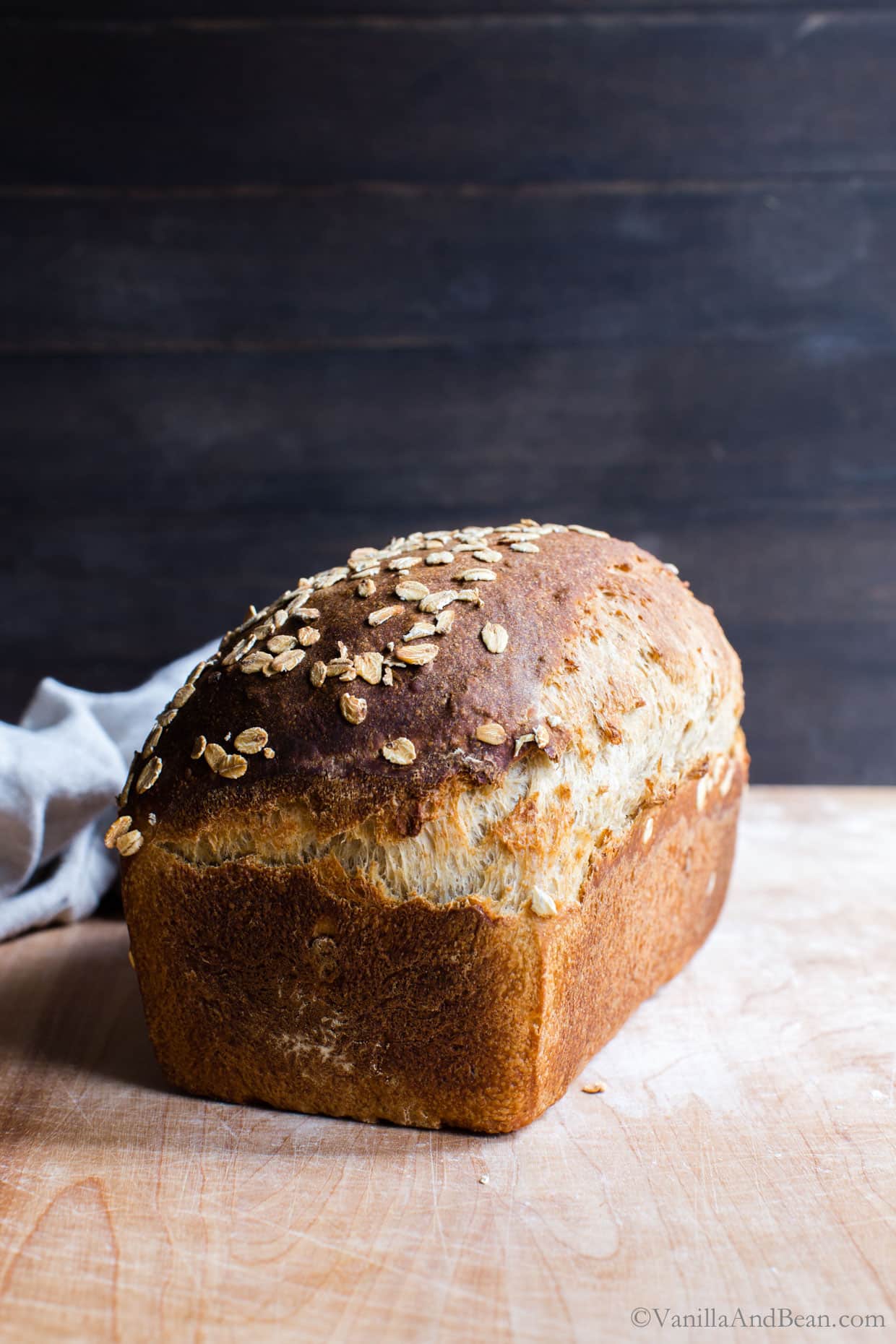
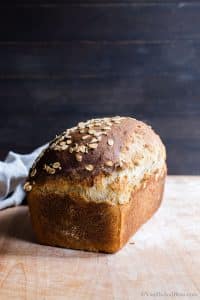
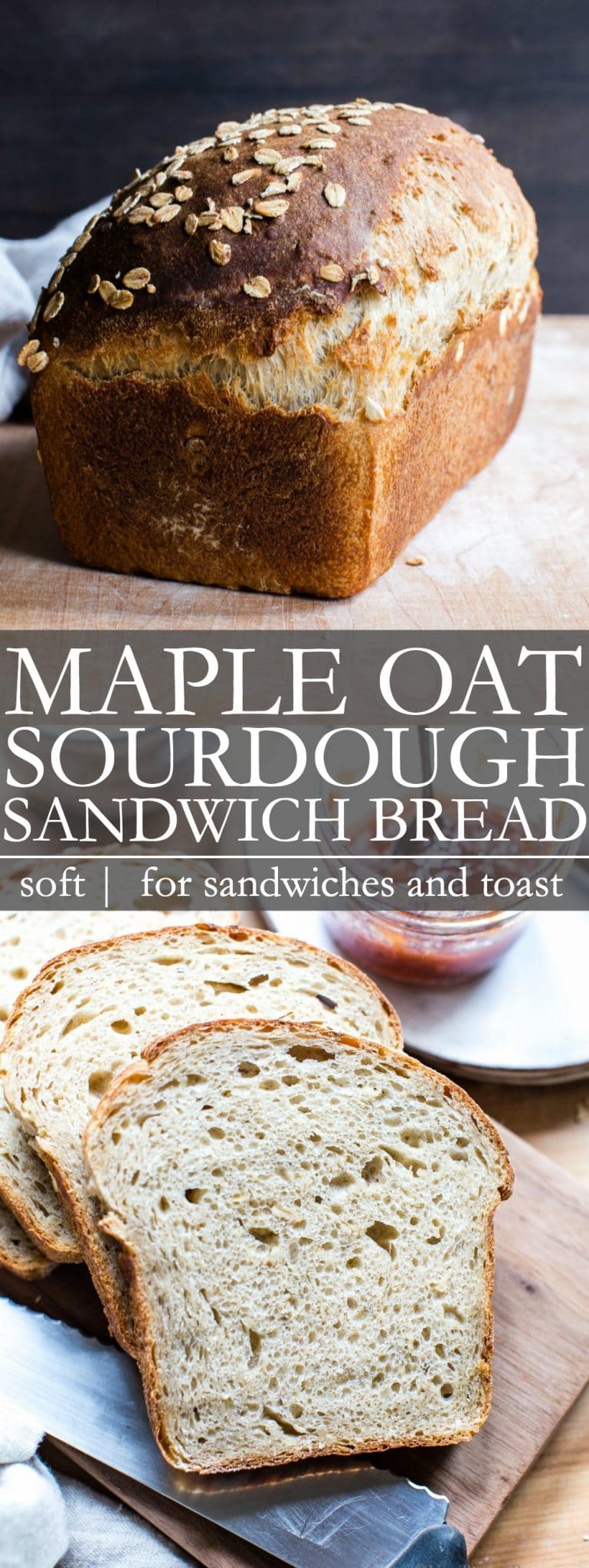
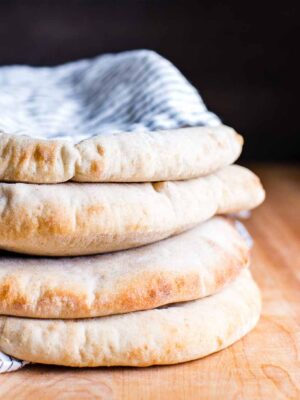
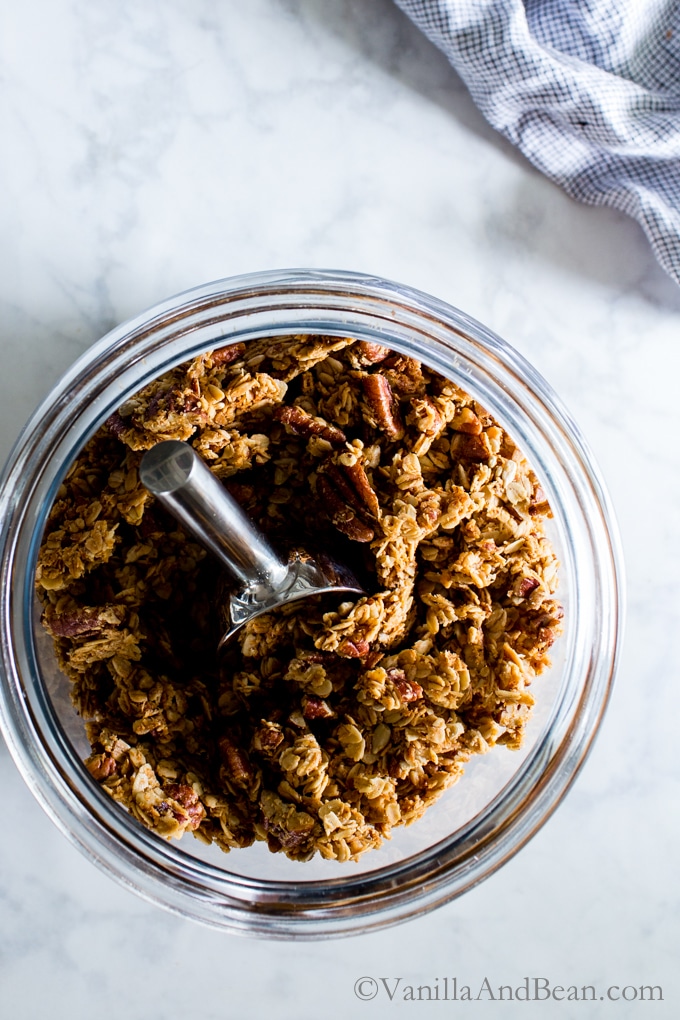
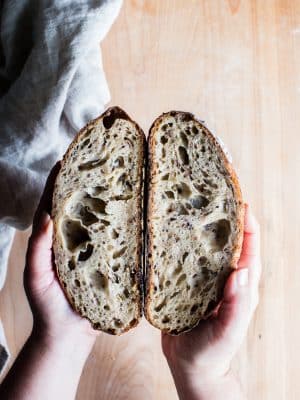
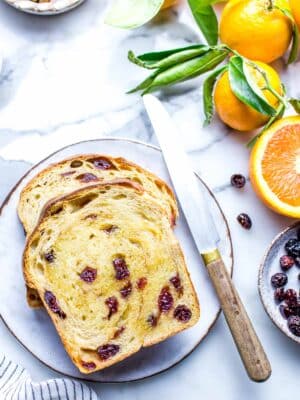
A perfect sandwich bread!!
Thanks for your awesome recipe!
My bread looks exactly the same with your bread pic above.
I replaced maple syrup with organic raw honey.
Hi Henny! SO happy to hear you’re enjoying the sourdough. Thank you for your note and sharing your tip about subbing maple with honey – delish!
I have been in search of the perfect sourdough sandwich bread recipe and I believe I have found the one with this! It turned out amazingly!!!
Hi Abby! Hooray! SO happy to hear and I truly appreciate your note. The oats offer such a nice flavor!
I have made your gluten free sourdough starter. Can I use gluten free starter for this bread?
Hi Leslie! Thank you for your note. While I’ve not tried a GF stater in this recipe, I don’t see why it wouldn’t work. Keep in mind the regular starter is 100% hydration whereas the GF starter is 130% hydration, so you may need a bit less water in the recipe. I hope this helps. Please keep us posted!
So glad I found this recipe!! I doubled it and made 2 loaves, and they turned out brilliantly! Soft, with a beautiful crumb, and fantastic flavor.
Hi Steph! Thank you for your note and giving the recipe a try. SO happy to hear you’re enjoying the sourdough. Aren’t the loaves so soft?!
Hi, had to leave a comment. I have made this recipe 3 times now. The first time it was a little wet because I was using all purpose flour…I know, but I shop at costco and get the huge bags, and I am stubborn. My husband (who mostly
prefers pure white bread) loved the first loaf though, and so did I! I ended up troubleshooting and and found that it helped, if using all purpose, like myself to decrease the water content by 30g, give or take a bit. The 3rd loaf was so beautiful. I am going to keep making this one for a while.
Hi Margaret! Hooray for a delicious loaf and with AP! Thank you for coming back and leaving a note, sharing your tip and sticking with the recipe (so smart) until you made it work! I know those huge bags of AP you’re talking about :D It’s a win-win that your husband loves it too!
This recipe is so amazing! I’ve had a sourdough starter for well over a year now (her name is Lola!) but I had never made bread before. Sourdough pizza dough, naan, English muffins, even pasta — but bread intimidated me for some reason. Anyway, I made this recipe for my first go at real bread, and it turned out perfect! It was easy to make, it turned out so soft and fluffy, and it tastes SO good. It’s perfect for toast or sandwiches. My husband also loves it! I’ve already made a second loaf and it turned out perfect as well. This is going to be a regular thing, for sure!
Hi Ashley! You did it! Can you hear me clapping? I’m so excited you took the leap… and now, you are making sourdough bread too! Thank you for your note :D
Hi Traci!
I baked this today, and it is a wonderful bread! I split it into two smaller loaves and it makes the perfect little sandwiches! I love the scent of maple and the tender crust. Thanks for the recipe!
Hi Sheri! Thank you for your note and tip about mini loaves! SO happy to hear!
Beautiful loaf that came out gorgeously in one try. I used whole wheat bread flour from Azure Standard and the crumb has phenomenal texture. I’ve made it twice in the last week, and the most recent loaf I accidentally over proofed it (underestimated TN humidity) and it still didn’t collapse despite being a good 3 inches over the pan. Great recipe, thank you for sharing your talents.
Hi Kitty! SO happy to hear you’re enjoying the sourdough. I’m amazing that the dough didn’t collapse (shew!). Thank you for coming back and leaving a note!
Delicious bread. Seemed complicated but turned out easier than I thought.
SO happy to hear Teresa! Thank you for your note :D
Beautiful Bread! It was so fun to make, tastes great, and let us not forget… it is filled with oat-ty goodness! Thank you for sharing this wonderful recipe.
Hi Debbie! Hooray! So happy to hear you’re enjoying the sourdough. I’m with you on the oaty goodness… it’s just has wonderful flavor! Thank you for your note.
is it normal for the dough to be wet and sticky in the middle of the folding process?
Hi Scout! In the middle of the folding process, the dough is still somewhat sticky. It should be able to hold somewhat of a shape at this point and should be more tackyish than wet. If it’s too wet, you can sprinkle in a tablespoon of flour as long as you’re doing another fold. I hope this helps!
outstanding!
So happy to hear, Abby! Thank you for coming back and leaving a note :D
Thanks for sharing! I bet kids love this recipe too!
It’s so soft and has a nice, slightly sweet edge!
This look so good! I love a good sweet bread! It’s so nice that it freezes too so you can make a couple at a time!
Thank you Suzanne! LMK if you give it a go!
I make a double loaf of this bread REGULARLY. It’s easily the best sourdough sandwich bread I’ve made and I’ve tried a LOT. Would love to see more sourdough sandwich loaf recipes! But in the mean time, I’ll keep making this tried and true recipe.
Hooray! Emily! Thank you for your note and giving the sourdough a go. So happy to hear! I’m working on more sourdough loaves… coming soon!
Thank you!! Made my first loaf of this – baked today.
This is a fabulous recipe and just may become my go to sourdough bread recipe!! Tastes great and looks great. Crust is very tasty but is softer than the artisanal style breads. Better for my expensive dental work ;-)
Hi Lesley! Thank you for your note and giving the recipe a go. So happy to hear you’re enjoying the sourdough, and that lighter and softer crumb!
It came out beautiful. I used a whole wheat starter and added 65g of whole wheat flour. Baked in a bigger Pullman loaf pan. Followed all the instructions as is – and it worked very well. I like the fact that it works with my schedule – a little work in the evening and then continue the next day, but not too early in the morning. I wish I could upload a picture of my bread here with the comment. Thank you for the recipe!
Hooray, Vera! Thank you for your note, sharing your tips and giving the sourdough a go! Isn’t it so nice how sourdough can fit into your schedule? I’d love to see a pic of your bread! Please send an email: traci@vanillaandbean.com
Love this recipe so much, thank you for sharing.
Thank you for your note Deb! :D
I am relatively new to sour dough bread baking but found this recipe to be way too labor intensive for the results. I appreciate the comprehensiveness of the directions and like using the oats soaker but found my bread to be kind of “doughy”. No complaints from the family and it will make great toast.
Hi Linda! I’m sorry this sourdough did not meet your expectations.
I was concerned that perhaps I made a mistake on the amount of flour because the dough was stiff and heavy throughout the stretch and folds. Although it did grow during fermentation, it never stopped being stiff. I went ahead and baked it — the resulting bread is slightly sweet, and moist yet light! A bit baffling but I will be making this again (though increasing amounts by 1/3 to better fit my sandwich mold). Great breakfast toast!
Hi Gabriela! Thank you for your note. I’m so happy to hear you’re enjoying the sourdough! Indeed, the dough is a bit stiffer due to the amount of whole grains. But a more tender bread emerges due to the oats! Baffling but what a nice result. I added a note on the recipe regarding rest time. Feel free to give the dough an additional 15 minutes between folds to help the dough relax. That’ll make it a bit easier to stretch! Please let us know if that helps!
My bread is delicious, but chewy. Should it be or did I do something wrong?
Hi Gain! Thank you for your note. So happy to hear you’re enjoying the sourdough. But this loaf should be soft, with a somewhat chewy crust. Was it the interior or exterior that was chewy… or both?
This loaf is so delicious! I’ve made it twice and both times it bakes a little lopsided. I think it has to do with my shaping. Any tips how to make it a bit more even?
Hi Mel! So happy to hear! Indeed, it’s the shaping. Here’s something different to try. Instead of folding in 1/3 then again, then folding the ends, try shaping into a rectangle the length of the pan and rolling the dough into a log (like cinnamon rolls). Pinch the bottom seem and transfer it to the pan. I hope this helps and the loaf comes out even next time!
This is DELICIOUS. Pretty sure I did something wrong because my loaf turned out gigantic haha but the bread tastes great. I will make this again! Thank you for sharing!
Hi Maddie! It sounds like you had some amazing oven spring (!!). Thank you for your note. So happy to hear!
I’m always on the lookout for super sandwich bread, as I bake 45 loaves a week to sell at a Farmers Market. This sounded super and is cooling on the counter now. Because I bake in such volume, I use a mixer and it worked fantastic and I didn’t have to stretch and fold. I also divided the dough into quarters and used the Japanese Milk Bread technique on it. It’s looks mighty good! Would love to show you a pic, but don’t know how on this site.
Hi Brenda! Thank you for your note and giving the recipe a go! Would love to try the Milk Bread technique on this loaf – how wonderful! I don’t have photo sharing capability here, but if you’re on IG or FB, you can share there or email me traci@vanillaandbean.com ! I’d love to see!
Hello! If my starter is maintained at 80% hydration, how would you recommend tweaking your recipe? Can’t wait to try!
Hi Jenny! At 80% hydration, I’m thinking you’d need to increase the water in the recipe only slightly. But by how much, I’m not exactly sure. I’m sorry I can’t be of more help.
I’m so excited to try this bread. I put it in the fridge overnight and have it proofing in my warm spot now! I love reading through comments.. next time I’m using honey and adding some seeds!! we love seed bread in our house but it’s so spendy!!
However…. I do not have one large loaf pan but 2 smaller loaf pans so we shall see how that plays out!! I’ll get a larger one when I can.
Cheers!!
Hi Sherice! Thank you for your note and giving the recipe a go. Honey and seeds sound lovely! How’d the smaller loaf pans work out?
Hi Traci,
looks amazing, and would like to try it .
is is ok to change maple sirup to honey, and what is the conversation rate is it 1:1?
thank you
Hi Aniko! Honey will work just fine – same amount, but it may darken the crust a little faster. You may need to tent the bread to protect the crust. Other makers have used it (see comments below) with success. I hope this helps and you enjoy the sourdough!
My absolute favorite bread. Everyone who tries it falls in love!
Awh, thank you for your note and giving the recipe a go Candace! I’m so happy to hear you and those that you’re sharing it with aare enjoying the sourdough. I think it’s the oats that really make this bread so flavorful!
This was my first attempt at traditional loaf of sourdough bread. It was easy to make and turned out great. Mine doesn’t have much air in the crumb but that’s okay for a sandwich loaf. I did think the directions were a little more detailed than necessary but I’ve been baking sourdough for a while now. I’ll definitely make this again.
Hi Dee! Thank you for your note and giving the recipe a go. So happy to hear you enjoyed the recipe!
This is one of my favorite loaves! I used steel cut oats and am so glad I did- it made the bread chewy and hearty. Next time I’ll cut back on the maple syrup. I also added maple extract. Maybe that’s cheating, but it’s very good. I also used almond milk. I fed my starter around 9am, mixed my dough around 5. All of my tests and stretches and folds were done around 7 so I let it bulk rise on the counter all night. Formed into a loaf pan around 6am and by 8, my bread was in the oven baking. My kids love it! Thanks for the recipe. It’s a keeper!
Hooray! Thank you for sharing your notes and success, Kelly! Did you cook the SCO before you added them to the dough? Maple extract sounds amazing!
I didn’t cook them! I boiled the water and let them soak for probably 30 minutes as I did the first steps of the recipe. They get a little soft before you incorporate them, but once the load is baked, the oats add a little soft crunch and texture that is perfect.
Ohhh Thank you for your tip Kelly! Sounds amazing!
Hi Traci. Thanks for this super delicious sourdough recipe. I’m new to the bread baking and sourdough world so am definitely on a learning curve. I have made this recipe several times (have a loaf fermenting on the counter now!) and it is my favorite of all the recipes I have tried so far, and there have been many. I use honey in place of maple since I’m not a big fan of maple flavor. My only issue has been that the loaves have been a bit dense at the bottom, but I’m sure this is not a recipe issue, rather me not having developed a good bakers instinct yet and not hitting the fermentation or proof timing right. Dense on the bottom has been consistent in most of my bakes. Any insight would be appreciated!
Hi Dana! Thank you for your note and enjoying the sourdough. SO happy to hear! With regards to the dense bottom, I’ve not experienced this. However, it seems to be a proofing issue from my quick search online. I’ve read a dense bottom can result when the dough is overproofed. Have you tried the poke test to make sure your dough is properly proofed prior to baking? Wet your finger and gently poke the dough with your fingertip. If it instantly springs back, it’s underproofed. If it doesn’t spring back at all, or only slightly, it’s overproofed. If the dough springs back in slow motion most of the way (but still leaves a slight indent), it’s ready to bake. It’s better to poke early than late. Too, be sure to keep a sharp eye on how high the dough has risen above the rim. Use a ruler and get down low so you can see the actual height next to the rim of the pan. I hope this helps Dana! Please keep us posted!
Just wanted to let you know I made a double batch of this bread and served one loaf at a party yesterday, just simply sliced with butter. Big hit! I love your idea for combining oats and maple into an enriched loaf. The flavor has a lot of complexity and the texture is so nice. I used steel cut oats because I like having the chewy pieces. I will make this regularly!
Hooray for a double batch! Isn’t that combination so comforting and delicious? I love the earthy notes of this loaf… so simple, but so enjoyable. Thank you for your tip on using steel cut oats. I’ll have to give that a go!
Great recipe, now on regular rotation in our house! Think it would work to add seeds?
Hi Elyse! Thank you for your note! I love this loaf too! Seeds would be delicious in this loaf, but I wouldn’t add more than maybe 4 Tbs as the bulk may become too much for the loaf pan. I hope this helps!
Traci-My husband and I love this bread. I’ve made it a few times with maple syrup as called for, but tried honey this week as suggested in a prior comment. The sweet/sour contrast is more subtle with the honey. Delicious! Thank you!
Hi Sheila! Thank you for your note and giving the recipe a go! SO happy to hear you’re enjoying the reicpe! Thank you for your tip about the honey :D
I LOVE LOVE this bread. After trying several different recipes, my family wants nothing else!
SO happy to hear Sharla! Thank you for your note and giving the recipe a go!
HI. I’m excited to try the recipe – any chance I can use water instead of milk? We are quarantined (again – at least this time it’s so 2 kids can go to college next week) and I don’t have any dairy-free milk in the house… Thanks!
Hi Natalie! It’ll be fine. You may have to adjust the hydration slightly (adding a bit more water). The bread won’t be quite as soft, but you’ll still have delicious bread! I hope this helps and you the transition to college goes okay.
Thanks for the recipe! Have you ever used steam for the first part of baking? I am so used to using steam for the first 15mins of baking, so just curious. I’d love to know your thoughts, though I’d assume you don’t as you didn’t put it in the recipe 😂.
Hi Amanda! Yes, I have. I haven’t done it in a while though because I busted the glass in the oven door by splattering cold water on it – I’m ruined. At the bakery, we used steam injected ovens. So, if you can do it, I say go for it! The crust is so nice either way – but crustier with steam. For this bread, I prefer a soft crust, so I don’t attempt steaming. I hope this helps!
Delicious! I will be making again and again. I did cut down on the maple syrup second time I made it and the bread still tasted wonderful.
Hi Jocelyn! Thank you for your note and giving the recipe a go. SO happy to hear you’re enjoying the sourdough!
This was excellent and the softest sourdough bread I have made so far
The extended time tips helped alot, with just letting it rise overnight. The flavor is just right. I will try to extend the timing on my other sourdough recipes. Thanks for the great recipe and teaching tips.
Made honey oat bread today , came out beautiful I will be it again, wonderful taste , love it.
So happy to hear Vena! Thank you for your note and giving the recipe a go!
This was fantastic! My favorite bread I’ve made. Thank you!
Hi, there!!
Quick question for you! I’m retarding the dough overnight in the fridge with plans to finish it up today once I get home from work. How long would you guess I’ll need to proof the dough once it comes out of the fridge? Would it be the full 8-10 hours? The hubs is working from home, so I was going to have him pull it out for me to get the rise started. I don’t know if I trust him to shape and bake it… :)
Hi Victoria! Bulk ferment until the dough doubles in size (in or out of the fridge or a combination of the two), then shape the dough. After you shape the dough and have it in the pan, proof the Dough (second rise): Cover the pan with a damp tea towel and allow the dough to rise until the dough rises to about 3/4″ – 1″ (2cm – 2.54cm) above the lip of the pan at the center of the dough. The amount of time will vary depending on ambient temperature. At 70F (21C) proofing takes about an hour. In my chilly kitchen, about two hours. LMK if you have any other questions! I hope this helps.
Hi Tracy. I baked your bread recipe today and I was wondering what was the weight of the baked bread in your case? I am pretty new to sourdough baking and still figuring out what to expect in each stage. It was pretty hot today, hence my first rise completed in around 5 hrs (doubled, jiggly, bubbles just beneath the surface), although dough was pretty sticky so had a tough time shaping. Unlike your bread, I ended up with harder crust. Not sure what I am doing wrong.
Hi Anish! Thank you for your note! I didn’t weigh this loaf, but I will next time I make it and will update the post. For bulk fermentation (first rise) try to slow that time down a bit, if anything, for flavor development. Retarding the dough in the fridge will slow the rise down a bit. The dough is sticky, and shaping takes practice. If needed, use moist hands to reduce sticking – there’s a fine balance between most hands and using flour to help us handle the dough. When mixing, you can reduce the hydration a bit maybe by 1/4 C first and add more if the dough seems to dry. As far as a harder crust, I’m not sure there. Did you add the oil?
Hi Traci,
My starter is 60%…what’s your recommended adjustment?
Hi Wendy… I’m afraid I don’t understand your question. Can you clarify please?
I made this as described, though I had to retard the second rise in the fridge for an hour or two. No problem. It rose beautifully and made a very sliceable, delicious loaf. Keep the sourdough recipes coming! I have tried all except for the croutons and every one has been a success.
Hi Andrea! Thank you for your note, kind words and giving the recipe a go! SO happy to hear you’re enjoying the sourdough (and other bread recipes on the blog!). Love how you retarded the dough to make it fit your schedule!
This is the perfect sandwich bread! Slightly sweet, slightly sour, with a tender and delicate crumb. For my first go at it I swapped honey in for the maple syrup because honey oat bread is my absolute fave (though I do plan to try it as written, you know, for comparison purposes), I used oat milk because that’s what I had, and I also upped the amount of bread flour to 400g. I think its my kitchen’s microclimate but less than 3 cups of flour to that amount of starter gives me a sloppy messy dough that is impossible to shape. Increasing the flour from the start made it a little tough to stretch but very easy to do a final shape on. Overall I’m definitely pleased with this recipe. Thanks Traci!
Hi Melanie! So happy to hear you’re enjoying the sourdough! Thank you for your note and sharing your tips and subs. So glad to hear you adjusted as needed and that the final shape was easy. I love the slightly sweet, slightly sour notes too…. and the crumb!
This worked great when I tried it. Followed instructions exactly as written and it turned out great, and the oats really aren’t that apparent in the final product.
Hi Rosemary! So happy to hear you’re enjoying the sourdough! Thank you for your note. Isn’t it so nice how the oats just melt into the crumb?
Hi! I love your 10 grain seeded sourdough loaf and just gave us a try. It turned out pretty well, but did not rise quite as much as yours did. Any ideas why that might be? I know the oven spring from the Dutch oven helps the other rounds along.
Hi Alison! I’m Curious about the proof. Did you allow it to rise to about 1” above the lip of the pan measured at the center of the dough?
Hi! I wanted to check as to how can I modify bulk fermentation and proofing timings in a very hot environment. Everytime I make sourdough I feel I tend to overproof it due to the hot environment I live in. Please let me know if you have any suggestions that could help.
Hi Sonam! You can slow down fermentation by putting the dough in the fridge theN allowing it to finish fermenting at room temp. Follow the signs (in the recipe) for when the dough is done bulk fermenting. For proofing, you want the dough to rise 1” above the lip of the pan at center… same as what the recipe indicates. You can try doing this in the fridge, but you’ll need to keep an eye on it, checking to see when it’s ready for baking.
I need to try this! Could I change the ratio of unbleached flour and whole wheat? I’d like to use more whole wheat. Also, in the past I’ve added a few tablespoons of wheat gluten when I’m out of bread flour, so I think I’ll try that too.
Hi Cheryl! While I’ve not made this loaf with a higher ratio of whole wheat, you can certainly give it a go. You’d need to adjust the hydration up, by how much, I’m not sure.
Very Nice Traci, I bake breads a lot and mine it’s always semi sourdough. I have not bake a regular sourdough yet. I will have to give a try…. Nice… Nathan
Thank you, Nathan!
Hi, I wanted to check the measurements of the loaf tin you mention – it says 9 x 5” but the cm equivalent don’t look right. 9” is about 23cm. Probably just typos but it confused me when reading the method
Now I’ve got the hang of sourdough bread I may give this a try as a loaf I can use for sandwiches is very appealing. Thanks for posting it
Hi Sue! Thanks for your catch. It’s fixed! That would be a tiny pan in cm!